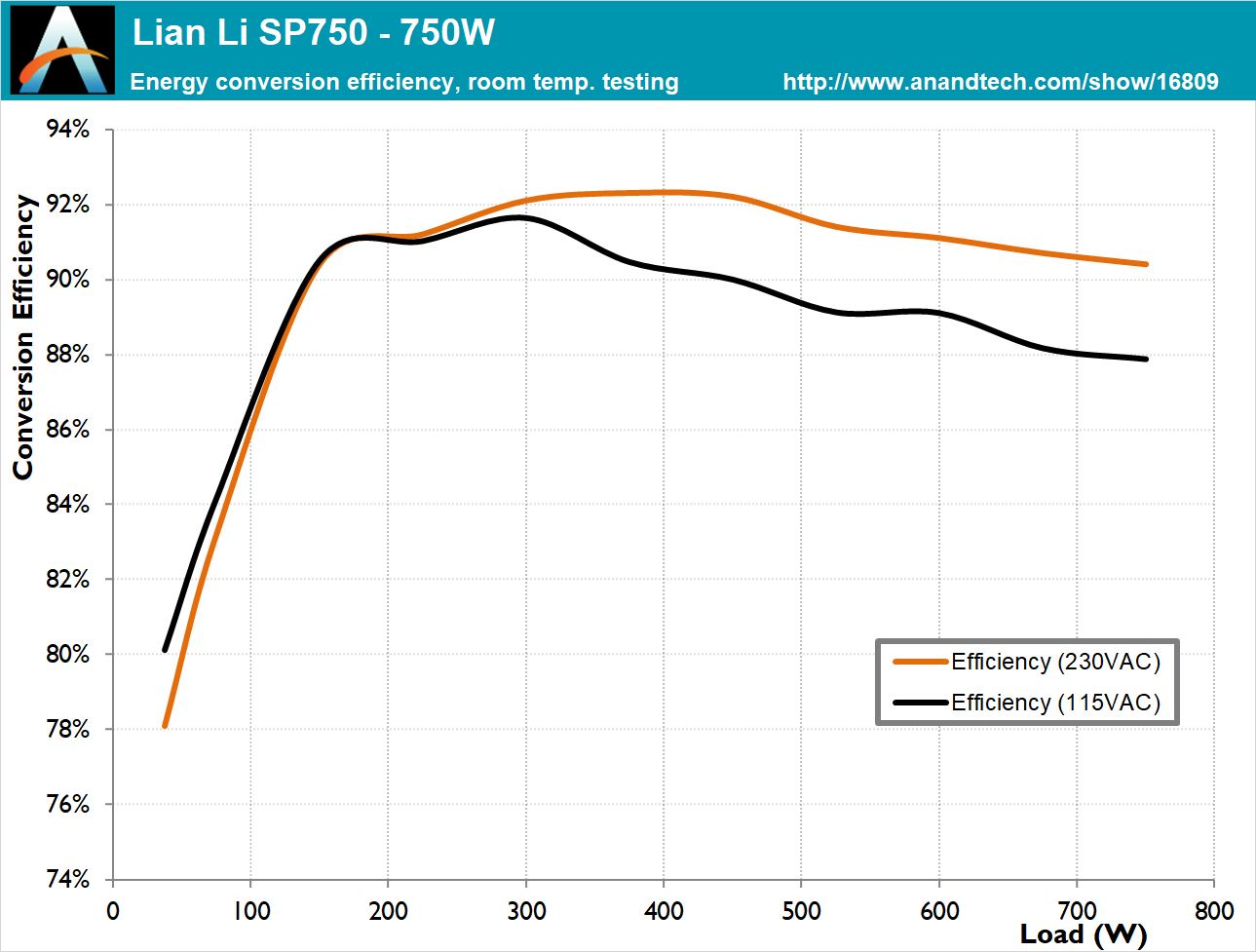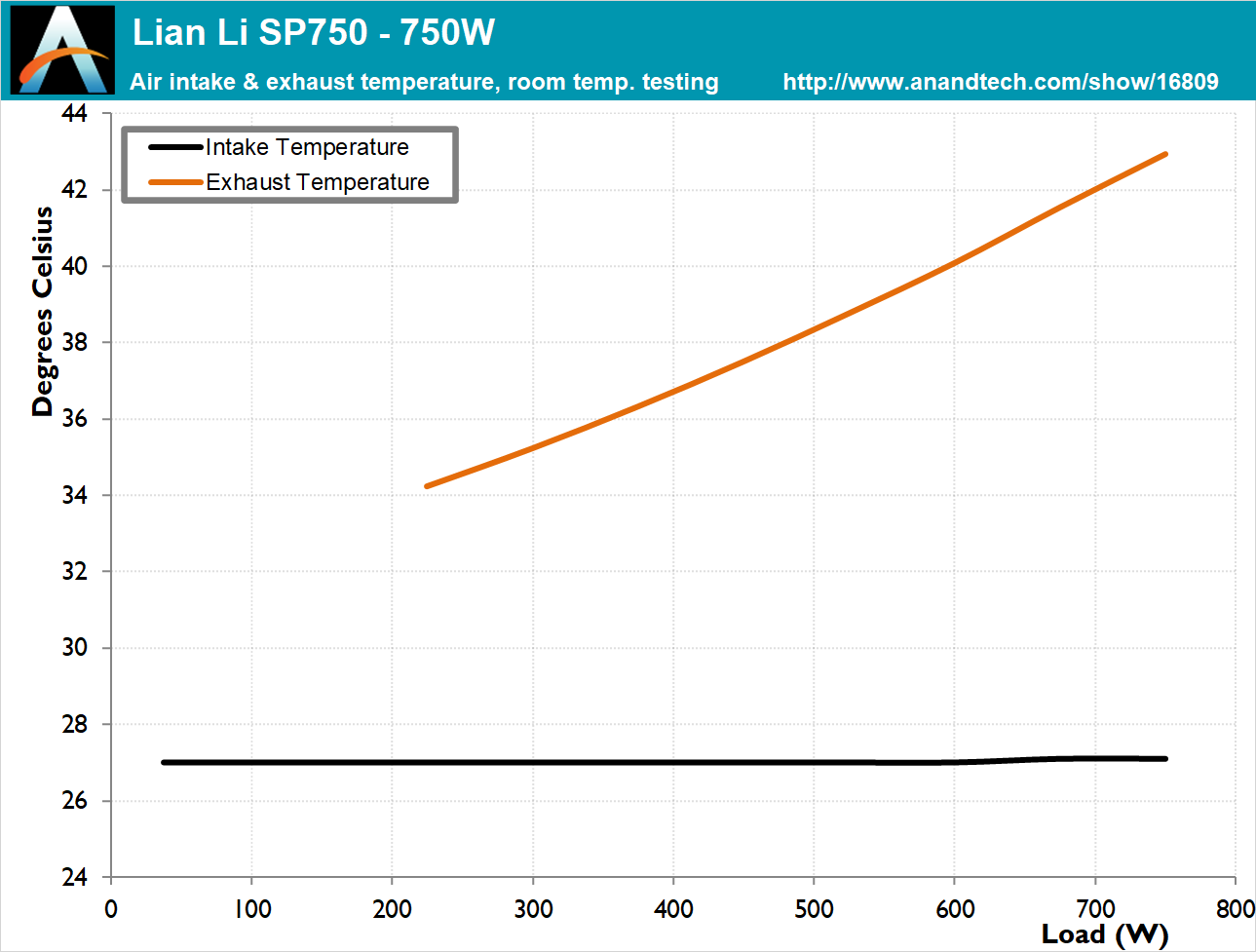The SP750 SFX Gold Review: Lian Li's First SFX Power Supply
by E. Fylladitakis on July 12, 2021 9:00 AM EST- Posted in
- Cases/Cooling/PSUs
- PSUs
- 80Plus Gold
- 750W
- SFF
- Lian Li
- SFX
- SP750
Cold Test Results (Room Ambient Temperature)
For our power supply testing, we are using high precision electronic loads with a maximum power draw of 2700 Watts, a Rigol DS5042M 40 MHz oscilloscope, an Extech 380803 power analyzer, two high precision UNI-T UT-325 digital thermometers, an Extech HD600 SPL meter, a self-designed hotbox and various other bits and parts. For a thorough explanation of our testing methodology and more details on our equipment, please refer to our How We Test PSUs post.
The efficiency of the Lian Li SP750 is good – and it had to be, considering the very high output and its small size. The unit meets the 80Plus Gold certification limit of 90% efficiency at 20% load when powered from a 230V AC source. When powered from a 115V AC source, the low load efficiency is actually even higher, easily granting the SP750 its 80Plus Gold certification. The average efficiency of the SP750 across its nominal load range is 91.3% when powered from a 230V AC source, or 89.7% when powered from a 115V AC source.
Lian Li has the SP750 designed so as to operate without turning on its fan up to 40% load (300 Watts). To be exact, the thermal control of the PSU is tuned so as to turn on the fan when the internal temperature of the unit reaches 60°C. At a room temperature of 25°C, that would happen when the load is about 300 Watts, hence Lian Li’s specification. With our higher room temperature, the fan started earlier, with the thermal control circuit starting the fan almost exactly at an internal temperature of 60°C.
The 92 mm fan started when our load was just over 200 Watts, with relatively low noise figures for a fan this size. Its double ball bearing engine is audible just as soon as the fan starts but stays at comfortable levels unit the load reaches about 550 Watts. At higher loads, the fan will be clearly audible from a distance, yet not unexpectedly so all things considered.















29 Comments
View All Comments
erinadreno - Monday, July 12, 2021 - link
Is it just me or the PCB layout looks like mirrored from Corsair's SF750?DanNeely - Monday, July 12, 2021 - link
Looking at photos from the review below I don't think so. Off the bat this one has the 2 coils on the side opposite the big capacitor stacked vertically instead of side by side, the heat sinks next ot the big cap are oriented differently; and while it's hard to be sure since al of the images here were taken at more of an angle I think the Lian-Li is more densely packed.https://pcper.com/2019/01/corsair-sf750-sfx-platin...
romrunning - Monday, July 12, 2021 - link
Thanks for the review! I am not surprised Lian Li entered the SFX market first, because not only do they manufacture a number of custom ITX cases (i.e. ready-made customers), but the SFX PSU market itself has fewer competitors. The ATX PSU market has enough already. Hence, it makes perfect sense to enter the SFX side first.The Corsair SF750 mostly dominates the SFX PSU market at the 750W point, so another competitor at that level is desirable. I'll be interested to see if this one made by Helly Technology is just as good, quality/reliability-wise, as the Corsair one.
The fan is hopefully not a bad choice. I would have wanted one chosen more for quiet operation, because I really treasure a quiet system, especially when ITX cases don't have as much internal volume to "deaden" the sound.
u.of.ipod - Monday, July 12, 2021 - link
I think it has less to do with the fan choice and more to do if they set the fan curve aggressive or not, and if they base the fan curve on actual temperature or just general load.romrunning - Monday, July 12, 2021 - link
The review said: "The 92 mm fan started when our load was just over 200 Watts", so it sounds like a more aggressive curve. I don't know if this unit has a specific "ECO-mode" or configurable semi-passive mode. I know on my SF750, I've yet to hear the fan in the PSU kick on past the initial system power-on. Personally, I'm okay with the fan running, as long as it stays quiet (or at least always less than the system/GPU fans). :)Oxford Guy - Tuesday, July 13, 2021 - link
'I think it has less to do with the fan choice and more to do if they set the fan curve aggressive or not'1. Ball bearing fans are noisy. Single-bearing fans are the worst.
The only exception I have seen to this rule is some single-speed dual-bearing low-RPM fans designed for high static pressure, which did seem to be very competitive with competing tech (e.g. 800 RPM model from industrial company whose name I can't recall).
The main reason, as far as I know, for using dual-bearing fans, is for high static pressure situations (i.e. radiators, especially those with airflow high resistance).
2. How aggressive the fan needs to be depends on various factors that can be controlled by the OEM, such as the quality of the electronics (efficiency) and the quality of the airflow/heatsink aspect. This review suggests that one of the sinks isn't very good and gold is not the best PSU electronics can do.
The profile isn't just plucked out of the sky. It has to provide adequate cooling under load.
romrunning - Monday, July 12, 2021 - link
"What is strange here is the presence of three PCI Express connectors, because the SP750 clearly has the power output for two middle-range graphics cards but the lack of a fourth connector deprives users from that choice"ITX boards only have one PCIe x16 slot for a dGPU, so this isn't a problem at all.
Slash3 - Monday, July 12, 2021 - link
There are a number of midsize cases that will hold a Micro ATX or full sized ATX motherboard, but still require an SFX power supply, including their own popular O11 Dynamic Mini.https://lian-li.com/product/o11-dynamic-mini/
meacupla - Monday, July 12, 2021 - link
dGPU is dead anyways, so it doesn't matter.DanNeely - Monday, July 12, 2021 - link
Only for gaming, not compute.